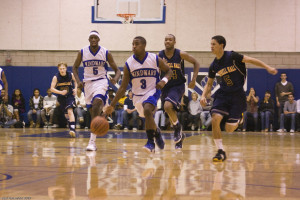Three Secrets of How to Bring Speed to your Fast Break
One thought that has crossed every coach’s mind at one time or another is how can I improve my Fast Break offense. If you are coaching a team and your team is not scoring between five and ten points a game out of fast break offense then you should be concerned. The fast break is the initial phase of any offense. Characterised by split second decision-making and thunderous movement up the floor. The fast break is a phase of the game poorly drilled and even less understood.
The number one characteristic of every consistently good fast break offense is speed with numbers. The three concepts below will work to build this idea into a reality.

The first aspect that needs to be developed is more of a mental condition than anything else. It is without negotiation or compromise that every player looks to reach the opposite baseline when a fast break starts. If any player feels like that do not have to invest in the fast break mentality of a team, it will only hinder the overall atmosphere and performance of the team. From the Seven foot starting Centre all the way down to the third string player in a position, everyone must invest!
Many poor decisions tend to be made in the fast break phase of offense. These poor decisions though can be overcome through sheer weight of numbers in many situations. Many lay-ups are often missed in fast break basketball only to have a trailing offensive player collect the rebound and make a scoring shot while the defence stands and watches.
This helps with speed by making the everyone accountable for being a part of the offense. No excuse, no compromise everyone is all in.
If the ball is being dribbled during a fast break, it is never dribbled on the spot, sidewards or backwards. The ball must always be advanced. If the ball cannot be advanced by the ball handler, they must pick the ball up and pass to a player ahead or on the move. This keeps the ball not only progressing to a more advantageous position, but also forces the defence to be constantly adjusting. The defence with every dribble or pass has to adjust alignment and ensure there is not a driving lane present for the ball handler. Speed then comes to a team’s fast break offense because there is no wasted over dribbling
When picking the ball up players are encouraged to finish in a jump-stop so they are able to pivot and pass from either foot. Passing on the run however is the most beneficial technique for keeping the ball alive in the fast break phase.
A Trailing player must never follow in another teammate’s lane or line to the basket. The first player involved in the fast break situation whether they have the ball or not will have the choice of laneways. All other players subsequently need to ensure they are not just filling in behind a player and only half committing to taking an active part in the offense.
When a player looks up and sees another player ahead of them in a fast break, they should instantaneously adjust their line to the basket or switch into a different lane. There are three lanes in the full court that should be filled early in all fast break situations. There are two wing lanes and a middle lane. Offense players initially should try to fill the wings first as this spreads the defence and provides a greater range of angles to attack the basket from.
Lines are the direct sight line to the basket for any offensive player on the court. In a fast break because of the speed of play and the defence retreating often they will be unable to make quick succession of movements. For this reason each offensive player must maintain a separate line to the basket. This ensure that if or when a pass is made they are always in a scoring position. It would not be unusual for a ball handler to draw a defensive player before making a pass to team mate only a few feet apart who goes on to score because the defensive player cannot recover in time.
If a player continues to adjust off the ball their lane or line to the basket, they will not have to make these decisions should they receive a pass. As a result speed will be improved by players taking less time once the ball is in their hand to try and find a driving lane for attacking the basket.
By installing these mindsets and effort-based principles to a team’s fast break phase then points will eventually flow. As always when practicing a new skill or tactic things will be shaky at the start. Provide plenty of opportunities for players to drill these principles in multiple player breakdowns. Constantly highlighting the areas in which each aspect can be implemented.







